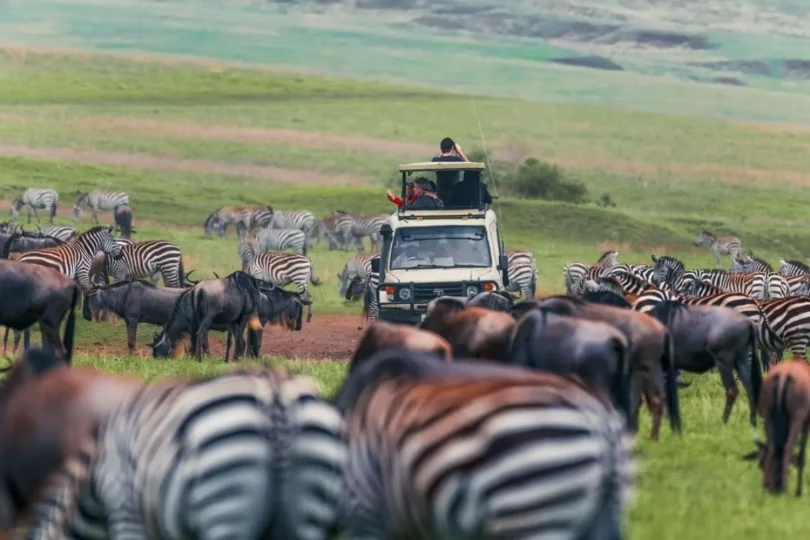How Do River Crossings Impact the Migration Cycle?
Every year, one of nature’s most breathtaking events unfolds in East Africa—the Great Migration. Millions of wildebeest, zebras, and gazelles move in a continuous cycle between Tanzania and Kenya in search of fresh grass and water. A critical part of this journey involves crossing dangerous rivers, especially the Mara River. These river crossings are not just dramatic moments; they shape the entire migration cycle. As a safari specialist at Seko Tours, I will guide you through how river crossings affect the Great Migration and what this means for travelers hoping to witness this incredible spectacle.
RELATED POST: Can I Drink Tap Water in Tanzania?
The Role of River Crossings in the Great Migration
The Great Migration is driven by one simple need: survival. These animals are constantly searching for greener pastures. While they face many obstacles along the way, crossing rivers like the Mara River is one of the most challenging and important phases of their journey. Here’s why:
- A Barrier Between Life and Death
- Rivers act as natural barriers that separate food sources.
- Wildebeests must cross these rivers to reach better grazing areas.
- If they don’t cross, they risk starvation as the dry season reduces available food.
- A Test of Strength and Survival
- River crossings test the physical endurance of wildebeests and zebras.
- The weak, sick, or injured often do not survive the crossing.
- Predator Danger at the River
- Crocodiles lurk in the waters, waiting to ambush migrating animals.
- On the riverbanks, lions, hyenas, and leopards wait for easy prey.
- A Key Part of the Migration Cycle
- The success or failure of river crossings determines the size and health of the herds.
- More animals surviving means a stronger migration the following year.
When and Where Do These Crossings Happen?
River crossings occur mainly at the Mara River, which runs between Tanzania’s Serengeti and Kenya’s Maasai Mara. These crossings usually happen between July and October, depending on rainfall patterns. The most famous crossings happen in the northern Serengeti and Maasai Mara, where thousands of animals plunge into the water, creating a breathtaking scene for travelers.
Factors Influencing River Crossings:
- Rainfall: More rain means more grass, leading animals to move towards new areas.
- Herd Behavior: Wildebeests follow the group; if one crosses, the rest follow.
- Predators: Fear of predators can cause panic, making crossings more chaotic.
The Drama of the River Crossings
If you have ever seen a river crossing, you know it is not just about moving from one place to another—it is a fight for survival. Here’s what happens:
- Gathering at the Riverbanks
- Thousands of wildebeests and zebras wait nervously at the edge of the river.
- They hesitate for hours, even days, before one brave animal takes the first leap.
- Panic and Chaos
- Once one jumps in, the rest follow in a stampede.
- The water churns as they struggle to swim across.
- Some animals drown due to exhaustion or strong currents.
- Crocodile Attacks
- Massive Nile crocodiles wait underwater, targeting weaker animals.
- Many wildebeests fall victim to these predators, but most make it across.
- Survival and Continuation
- Those who survive continue their journey towards greener grass.
- Calves and weaker animals often get separated, but the migration must go on.
How River Crossings Shape the Future of the Migration
The number of animals that successfully cross rivers directly affects future generations. Here’s how:
- More Survivors Mean a Stronger Migration
- If many animals survive, the population remains strong.
- This ensures a large migration in the coming years.
- Deaths Create a Natural Balance
- Those that die provide food for predators and scavengers.
- This maintains balance in the ecosystem.
- The Cycle Continues
- After the river crossings, the herds move into the Maasai Mara.
- Later, they return to the Serengeti, completing the cycle.
RELATED POST: What Should I Do If I Encounter Dangerous Animals?
Witnessing the Migration with Seko Tours
Seeing a river crossing is an unforgettable experience. The tension, the power of nature, and the incredible survival instinct of these animals make it one of the most exciting wildlife spectacles on Earth. At Seko Tours, we specialize in crafting personalized safari experiences in Kenya and Tanzania, ensuring you are at the right place at the right time to witness these dramatic crossings.



